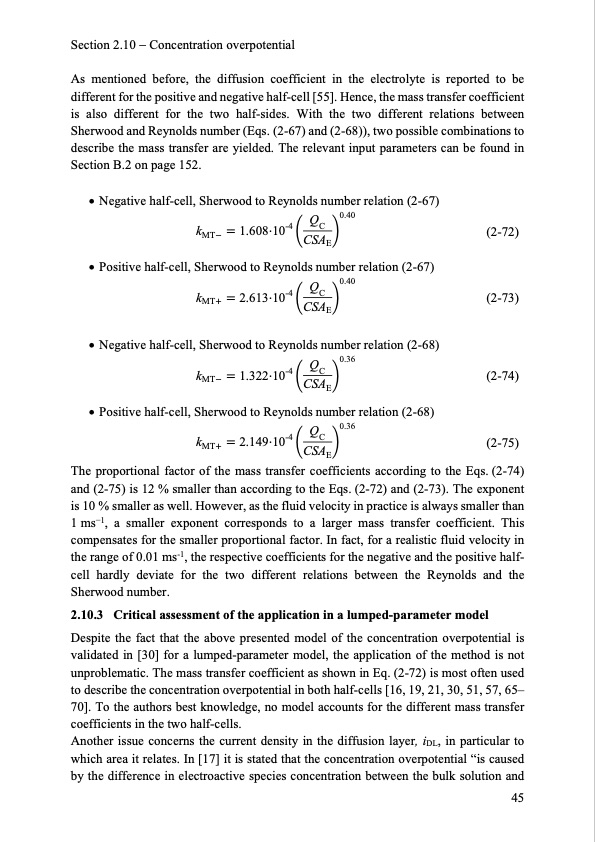
PDF Publication Title:
Text from PDF Page: 053
Section 2.10 Concentration overpotential As mentioned before, the diffusion coefficient in the electrolyte is reported to be different for the positive and negative half-cell [55]. Hence, the mass transfer coefficient is also different for the two half-sides. With the two different relations between Sherwood and Reynolds number (Eqs. (2-67) and (2-68)), two possible combinations to describe the mass transfer are yielded. The relevant input parameters can be found in Section B.2 on page 152. Negative half-cell, Sherwood to Reynolds number relation (2-67) Q 0.40 kMT 1.608⋅10-4 C CSAE Positive half-cell, Sherwood to Reynolds number relation (2-67) Q 0.40 kMT 2.613⋅10-4 C CSAE Negative half-cell, Sherwood to Reynolds number relation (2-68) Q 0.36 kMT 1.322⋅10-4 C CSAE Positive half-cell, Sherwood to Reynolds number relation (2-68) Q 0.36 kMT 2.149⋅10-4 C CSAE (2-72) (2-73) (2-74) (2-75) The proportional factor of the mass transfer coefficients according to the Eqs. (2-74) and (2-75) is 12 % smaller than according to the Eqs. (2-72) and (2-73). The exponent is 10 % smaller as well. However, as the fluid velocity in practice is always smaller than 1 ms−1, a smaller exponent corresponds to a larger mass transfer coefficient. This compensates for the smaller proportional factor. In fact, for a realistic fluid velocity in the range of 0.01 ms-1, the respective coefficients for the negative and the positive half- cell hardly deviate for the two different relations between the Reynolds and the Sherwood number. 2.10.3 Critical assessment of the application in a lumped-parameter model Despite the fact that the above presented model of the concentration overpotential is validated in [30] for a lumped-parameter model, the application of the method is not unproblematic. The mass transfer coefficient as shown in Eq. (2-72) is most often used to describe the concentration overpotential in both half-cells [16, 19, 21, 30, 51, 57, 65– 70]. To the authors best knowledge, no model accounts for the different mass transfer coefficients in the two half-cells. Another issue concerns the current density in the diffusion layer, iDL, in particular to which area it relates. In [17] it is stated that the concentration overpotential “is caused by the difference in electroactive species concentration between the bulk solution and 45PDF Image | Model-based Design Vanadium Redox Flow Batteries

PDF Search Title:
Model-based Design Vanadium Redox Flow BatteriesOriginal File Name Searched:
10-5445IR1000070670.pdfDIY PDF Search: Google It | Yahoo | Bing
Salgenx Redox Flow Battery Technology: Salt water flow battery technology with low cost and great energy density that can be used for power storage and thermal storage. Let us de-risk your production using our license. Our aqueous flow battery is less cost than Tesla Megapack and available faster. Redox flow battery. No membrane needed like with Vanadium, or Bromine. Salgenx flow battery
| CONTACT TEL: 608-238-6001 Email: greg@salgenx.com | RSS | AMP |